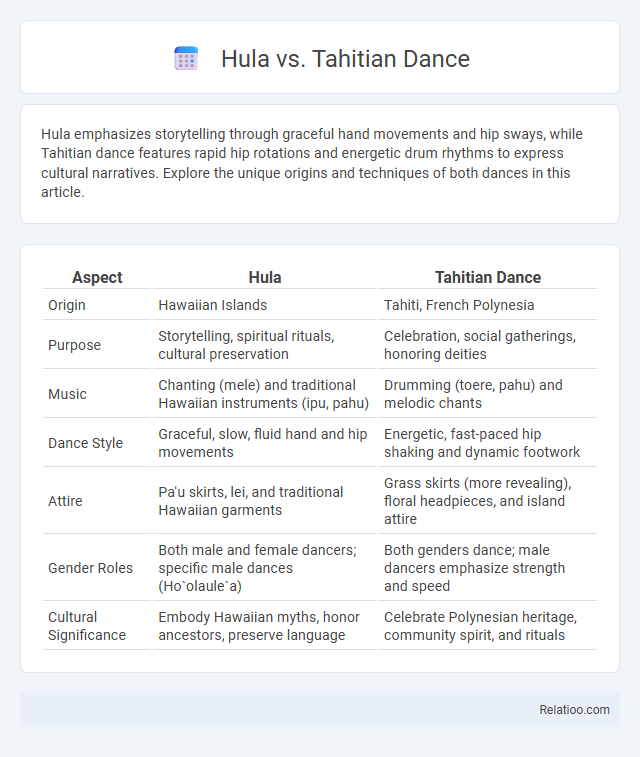Hula emphasizes storytelling through graceful hand movements and hip sways, while Tahitian dance features rapid hip rotations and energetic drum rhythms to express cultural narratives. Explore the unique origins and techniques of both dances in this article.
Table of Comparison
| Aspect | Hula | Tahitian Dance |
|---|---|---|
| Origin | Hawaiian Islands | Tahiti, French Polynesia |
| Purpose | Storytelling, spiritual rituals, cultural preservation | Celebration, social gatherings, honoring deities |
| Music | Chanting (mele) and traditional Hawaiian instruments (ipu, pahu) | Drumming (toere, pahu) and melodic chants |
| Dance Style | Graceful, slow, fluid hand and hip movements | Energetic, fast-paced hip shaking and dynamic footwork |
| Attire | Pa'u skirts, lei, and traditional Hawaiian garments | Grass skirts (more revealing), floral headpieces, and island attire |
| Gender Roles | Both male and female dancers; specific male dances (Ho`olaule`a) | Both genders dance; male dancers emphasize strength and speed |
| Cultural Significance | Embody Hawaiian myths, honor ancestors, preserve language | Celebrate Polynesian heritage, community spirit, and rituals |
Introduction to Hula and Tahitian Dance
Hula and Tahitian dance are traditional Polynesian dances distinguished by their unique movements and cultural significance. Hula, originating from Hawaii, emphasizes graceful hand gestures that tell stories or convey natural elements, while Tahitian dance from Tahiti features rapid hip-shaking and energetic rhythms. Understanding these dance styles deepens Your appreciation of Polynesian heritage and its diverse expressions through movement.
Origins and Historical Background
Hula originates from the Hawaiian Islands as an ancient Polynesian dance deeply connected to storytelling and spiritual rituals, often accompanied by chants or traditional instruments. Tahitian dance, known as 'Ori Tahiti,' comes from Tahiti and features fast-paced rhythmic movements tailored to vibrant drumbeats, reflecting the island's cultural expressions and ceremonies. Your understanding of these dances highlights their unique historical backgrounds that showcase distinct Polynesian cultural identities through movement and music.
Distinctive Movements and Techniques
Hula emphasizes fluid hand gestures that tell stories, flowing hip movements, and grounded footwork reflecting Hawaiian culture, while Tahitian dance features rapid hip shaking (ote'a) with sharp, energetic hip isolations and traditional drum rhythms. Dance, in a broader sense, encompasses a variety of styles with diverse techniques and movements tailored to different cultures and purposes. Understanding these distinctive movements helps you appreciate each dance's unique expression and cultural significance.
Musical Accompaniment and Instruments
Hula dance features melodic chants or songs called mele, accompanied by traditional instruments such as the ipu (gourd drum), pahu (wooden drum), and pahu heiau (temple drum), creating a rhythmic and vocal storytelling experience. Tahitian dance relies heavily on fast-paced percussive beats produced by instruments like the toere (slit drum) and pahu drums, emphasizing dynamic hip movements and energetic rhythms. Your understanding of these dances' musical accompaniment helps distinguish Hula's lyrical chant-driven flow from Tahitian dance's powerful, drum-centric energy.
Costume Differences and Cultural Significance
Hula costumes traditionally feature grass skirts, lei, and natural materials symbolizing Hawaii's connection to nature and spirituality, while Tahitian dance costumes are more elaborate, often including bright, feathered skirts, shell necklaces, and headdresses representing the vibrant Polynesian island culture. Your attire in Hula emphasizes storytelling through gentle, flowing movements, whereas Tahitian dance costumes highlight dynamic, rapid hip motions with bold, visually striking garments. Both styles hold deep cultural significance, with Hula often conveying legends and history and Tahitian dance celebrating social events and tribal identity.
Storytelling Styles and Meanings
Hula dance from Hawaii uses gentle, flowing movements and hand gestures to narrate stories of nature, mythology, and ancestral history, emphasizing deep cultural and spiritual connections. Tahitian dance features fast, rhythmic hip motions and vibrant footwork to express themes of celebration, fertility, and daily life, reflecting the energetic spirit of Polynesian islanders. Your understanding of these storytelling styles highlights how each dance uniquely conveys meaningful narratives through distinct physical expressions and cultural symbolism.
Performance Contexts and Occasions
Hula traditionally thrives in Hawaiian cultural ceremonies, storytelling, and celebrations, performed with chants and melodic percussion to convey legends and history. Tahitian dance, characterized by energetic hip movements and vibrant costumes, is often showcased at festivals, competitive events, and tourist performances reflecting Polynesian heritage. Your choice between these dances depends on whether you seek a narrative-driven ceremonial experience or a dynamic, rhythmic cultural display.
Modern Influences and Global Spread
Hula, rooted in Hawaiian culture, blends traditional chants and movements with contemporary themes, reflecting modern social issues and global artistic trends. Tahitian dance, characterized by its fast hip-shaking and vibrant costumes, embraces influences from Polynesian migration and international performance circuits, enhancing its visibility worldwide. Both dance forms have transcended local boundaries through global festivals, online platforms, and cross-cultural collaborations, driving their evolution and international appeal.
Learning and Practicing Each Dance
Learning Hula involves mastering graceful hand movements and storytelling through gestures, requiring consistent practice to synchronize steps with traditional chants or songs. Tahitian dance demands energetic hip movements and rapid footwork that build stamina and precision, best developed through repetitive drills and cultural immersion. Your practice routine should include watching authentic performances, receiving instruction from experienced teachers, and dedicating regular time to perfect each dance's unique techniques and rhythms.
Choosing Between Hula and Tahitian Dance
Choosing between Hula and Tahitian dance depends on your interest in cultural storytelling versus dynamic athleticism; Hula emphasizes graceful hand movements and chants that narrate Hawaiian legends, while Tahitian dance showcases rapid hip shaking and energetic drumming rhythms. Your decision should consider the dance style that resonates with your physical capabilities and cultural appreciation, as Hula offers a spiritual, narrative experience, whereas Tahitian dance delivers a vibrant, physically demanding performance. Both dances require dedication but provide distinct avenues to connect with Polynesian heritage through movement.

Infographic: Hula vs Tahitian Dance
 relatioo.com
relatioo.com